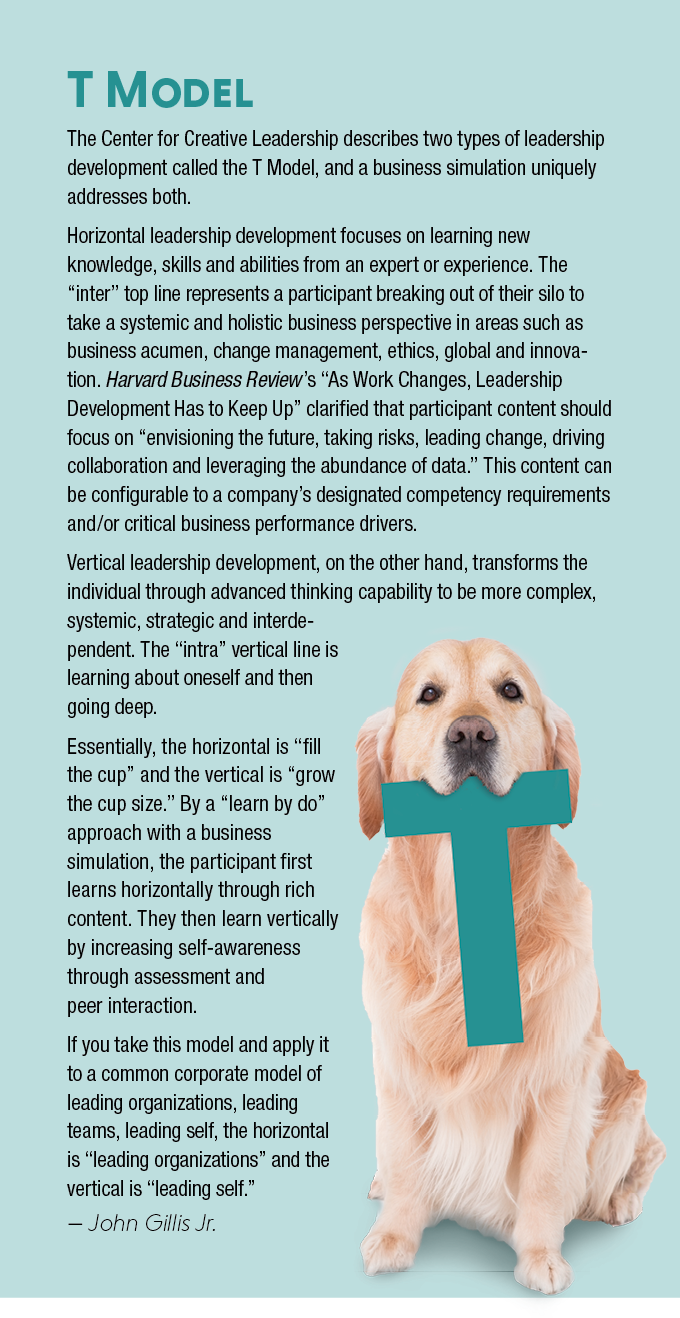According to The Conference Board’s “The Business Value of Leadership Development” report, “One of the most influential internal engines to drive change is a leadership development program that sets out to nurture management talent that is entrepreneurial, enterprisewide and globally recruited.”
Many agree with this sentiment and believe that for a company to seize competitive advantage for sustainability, it must invest in high-touch, face-to-face leadership development that is aligned with corporate strategy.
Unfortunately, most current leadership development efforts are falling short when it comes to the “high-touch” aspect.
Impact Shortfall
McKinsey & Co. estimated that leadership strength explained 80 percent of its sustainable performance. The Center for Creative Leadership reported that if done correctly, leadership development creates competitive advantage by driving strategy execution, navigating change, improving financial performance and retaining talent. Because of this noted impact, Deloitte previously reported that 85 percent of human resources leaders rate leadership pipeline as the top priority of companies. Willis Towers Watson and Development Dimensions International have published similar reports.
Additionally, The Conference Board’s “C-Suite Challenge 2018” listed developing next-generation leaders as the No. 5 CEO issue last year, between No. 4 — new global competitors and No. 6 — cybersecurity. And Chief Learning Officer’s Business Intelligence Board reported that 94 percent of companies plan to maintain or increase their investment in leadership development in order to grow their succession pipeline, retain their high-potential employees and foster innovation and creative thinking.
Done effectively, leadership development can have a positive impact on the business (sales, customer satisfaction, operational efficiency), ultimately leading to a beneficial ROI. For one-third of the companies that invest in their talent, this amount translates to more than $4,000 per employee annually.
In short, organizations have spent billions of dollars on leadership development. However, though there is a consensus on the importance of the effort, there is also a consensus that today’s offerings are inadequate. There is disappointing evidence of books, lectures and conferences having any sustainable impact. In the words of The Wall Street Journal, “So much training, so little to show for it.”
Few organizations have enough talented leaders in place and the current leadership development efforts are not paying off. McKinsey noted that companies are failing to develop the leaders they need, with 57 percent reporting that they are not confident that their training has impact. DDI supported this when it said only 40 percent of leaders report that their leadership quality is high, and only 15 percent have a strong leadership bench. Fortune really hit the message home when they said that only 1 in 10 CEOs believe their leadership development initiatives have a clear business impact. Deloitte’s “High-Impact Leadership” report shows that these result in a widening capability gap for building great leaders, with weak cross-industry leadership pipelines.
Why are CLOs getting such a failing grade with leadership development?
Leadership coach and author Marshall Goldsmith said, “Many of our leadership programs are based on the faulty assumption that if we show people what to do, they can automatically do it.” However, there is a difference between knowing what good leadership looks like and being able to do it. It is not listening to a “sage on stage,” where participants retain 5 to 10 percent of the information, according to National Training Laboratories. These lectures, which consist of reading a series of PowerPoint slides, are not an effective way to learn. Yet we keep doing this at conferences and in our classrooms. Even with low efficacy, we do not innovate beyond this traditional teaching method. (Note: “innovating” from an overhead projector to a PowerPoint presentation is not changing the delivery method, it is only changing the technology that puts the bullets on the screen for students to read and copy down.)
The Simulation Solution
Harvard Business Review’s October 2016 article, “As Work Changes, Leadership Development Has to Keep Up” said that companies “must deliver engaging, experiential learning opportunities that are rich with high-fidelity simulations and real-life applications.” In the airline industry, simulations are an effective way for pilots to learn from virtual experiences that would be costly and difficult or dangerous to provide in the real world. For businesses, leaders also need to prepare and practice so they can learn from their mistakes in a life-like setting. These experiential learning methods have a much higher retention of 80 to 90 percent, according to National Training Laboratories.
Just like effective flight simulations, companies need to invest in experience-based learning to improve learning retention. This hands-on learning challenges, immerses and engages participants intellectually with their peers in a safe environment. Here, participants practice critical analysis, problem-solving and decision-making. It is all about preparation and practice before performance.
If you are evaluating your programs based on the 4-level Kirkpatrick Model, experiential learning’s participant engagement not only leads to high level 1 participant evaluations (reaction), but the increased retention and behavior change at one’s job have a huge impact on level 2, 3 and 4 evaluations as well (learning, behavior and results, respectively). As participants apply their changed behavior back on the job, CEOs will begin to believe again in your leadership development program outcomes. The current low survey ratings will flip. This will be a lagging indicator that you as a learning leader are building effective leaders to achieve desirable business results.
Business Simulation
In Harvard Business Review’s “Games Can Make You a Better Strategist,” published in September 2015, the authors noted that games immerse you in a hands-on environment with instant feedback. As you analyze a  situation with critical thinking to make effective risk-taking decisions while executing your cross-function business, you learn through quarterly reports on your business outcomes: consequences or successes. How will you solve your challenges? Participants can experience quarterly performance in minutes, as well as several years of execution in two to four days. They develop new skills in a safe environment that is high fidelity because it mirrors real-world, competitive situations similar to the context of their organization’s strategy.
situation with critical thinking to make effective risk-taking decisions while executing your cross-function business, you learn through quarterly reports on your business outcomes: consequences or successes. How will you solve your challenges? Participants can experience quarterly performance in minutes, as well as several years of execution in two to four days. They develop new skills in a safe environment that is high fidelity because it mirrors real-world, competitive situations similar to the context of their organization’s strategy.
While the simulation experience engages participants’ attention through mental and social challenges, many companies stop there and fail to gain the full benefit of this experiential learning. To reach the true potential of the experience, you need a professional facilitator who debriefs what happened in the simulation, how team leaders interacted and what applicable takeaways apply that reach across their company. This deeper analysis provides insight for leaders to reflect on and decide what behavior modifications they need to make in their real-life circumstances.
This is the sweet spot — why a business simulation’s learning potential is far greater than any other training room learning method.
Sustaining Development
For learning to reach its business value impact, you need compelling learning transfer and application back on the job. Not only do participants practice concepts during the business simulation, they also have an experience to share with coaches in ongoing development.
Consider the following questions a coach might discuss with a participant:
Problem-solving: How did you make evidence-based decisions under time pressure, even when information is ambiguous once analyzed?
Results orientation: What financial metrics did you prioritize to assess performance achievement?
Innovation: How did your team balance innovation with execution efficiency?
Teamwork: What inclusive communication process enabled the team to collaborate effectively?
Self-awareness: As you adjusted behavior to adapt to the situation, did your peers trust your authenticity
The benefit of structured coaching is tailoring the learning to an individual for self-discovery. They review their assessment results for insight, their action plan for behavior change and their goals for action. Along the way, there will be obstacles to discuss and workarounds to determine in order to succeed. There is accountability for applying their learning at their job to achieve personal growth, even when faced with rigid resistance to change. A good leadership development program has system reinforcement to track, measure and lock in this desired behavior change.
Part of effective coaching is assessment. There are many high-quality assessments in the market today; the challenge is alignment of the assessment criteria to the rest of the leadership development process: content, simulation, learning objectives and job description. Once aligned, the insights from the assessment build self-awareness to drive effective behavioral change.
Learn, Experience, Apply
It is the classic “learn, experience, apply” model. Gain knowledge through configurable and customizable content, practice this new learning with adjusted behaviors in a safe environment and then take that experience to change your actions at your job. You are connecting knowledge with application!
After all, learning without application is worthless, and the lack of application is why many executives rate their programs as ineffective — because they don’t see the behavior change post-program.
As Ben Franklin said, “Tell me and I forget, teach me and I may remember, involve me and I learn.”















